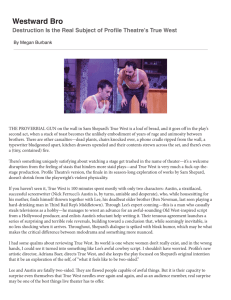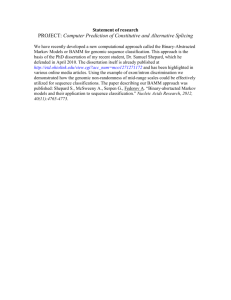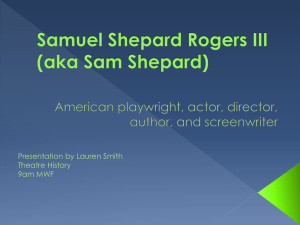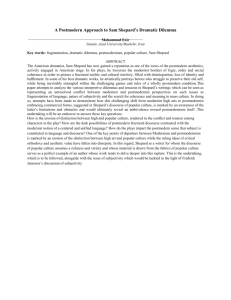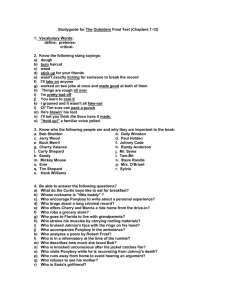Shepard.op - Florida Attorney General
advertisement
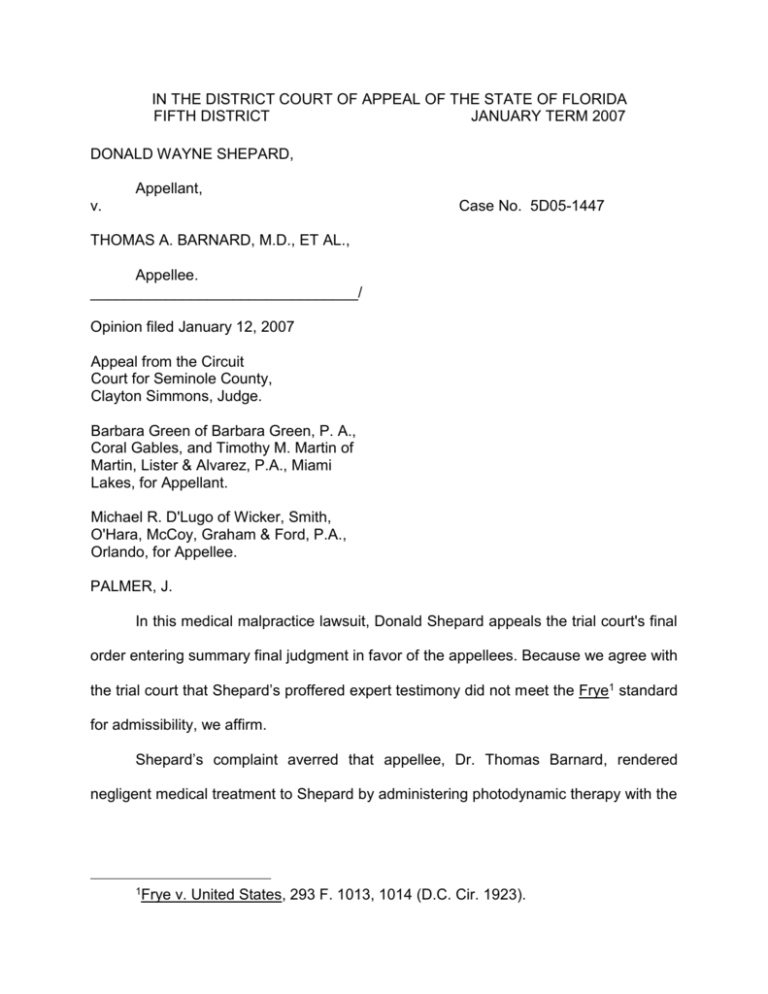
IN THE DISTRICT COURT OF APPEAL OF THE STATE OF FLORIDA FIFTH DISTRICT JANUARY TERM 2007 DONALD WAYNE SHEPARD, Appellant, v. Case No. 5D05-1447 THOMAS A. BARNARD, M.D., ET AL., Appellee. ________________________________/ Opinion filed January 12, 2007 Appeal from the Circuit Court for Seminole County, Clayton Simmons, Judge. Barbara Green of Barbara Green, P. A., Coral Gables, and Timothy M. Martin of Martin, Lister & Alvarez, P.A., Miami Lakes, for Appellant. Michael R. D'Lugo of Wicker, Smith, O'Hara, McCoy, Graham & Ford, P.A., Orlando, for Appellee. PALMER, J. In this medical malpractice lawsuit, Donald Shepard appeals the trial court's final order entering summary final judgment in favor of the appellees. Because we agree with the trial court that Shepard’s proffered expert testimony did not meet the Frye1 standard for admissibility, we affirm. Shepard’s complaint averred that appellee, Dr. Thomas Barnard, rendered negligent medical treatment to Shepard by administering photodynamic therapy with the 1Frye v. United States, 293 F. 1013, 1014 (D.C. Cir. 1923). drug, Verteporfin. Shepard's complaint averred that Shepard suffered a permanent photoallergy as a result of Barnard’s administration of Verteporfin. Shepard’s two causation experts were deposed pretrial. Dr. Wurpel, an associate professor of pharmaceutical sciences, testified he had never engaged in any research with regard to photosensitizing drugs or with Verteporfin. He further stated that, prior to this case, he had never heard of anyone suffering a photoallergy as a result of being exposed to Verteporfin. Wurpul testified that there was no mention in any of his research of any patient ever suffering a permanent photoallergy from Verteporfin, nor had any such phenomenon ever been reported in any scientific literature. He nonetheless concluded that, in his opinion, Dr. Barnard’s use of Verteporfin lead to a photoreaction in Shepard. When asked to explain the basis for his opinion, Wurpul stated that it was the "temporal relationship" between the date Shepard took the drug and the date he sustained his injuries, combined with the fact that Verteporfin is a "photosensitizing drug.” Shepard’s second expert was his treating physician, Dr. Chun, a physician specializing in dermatology. Chun explained that Shepard came to his office complaining he was suffering from severe sunburns after having ingested Verteporfin. Chun stated he had not had any experience with Verteporfin and therefore he began to do some reading. He did not, however, read anything about a direct relationship between Verteporfin and skin sensitivity. Chun further stated he was not aware of any scientific studies of Verteporfin where there had been a permanent photosensitive reaction. Chun stated that he had never done any research on Verteporfin and he 2 never used the drug in his practice, but that he believes that the Verteporfin did play a role in Shepard’s condition. The defendants filed a motion to strike the causation testimony of both Dr. Wurpel and Dr. Chun, pursuant to Frye v. United States, 293 F.1013 (D.C. Cir. 1923), arguing that their opinions that use of Verteporfin could cause permanent photoallergy were not generally accepted in the relevant scientific community and, as such, the opinions did not have sufficient reliability to permit admission at trial. Additionally, the motion alleged that, since these two witnesses were the only witnesses to provide opinions regarding any causal link between Shepard's alleged injury and the medical treatment rendered by Dr. Barnard, entry of summary judgment against Shepard was warranted. Following the hearing, the trial court granted the motion to strike Shepard’s expert causation testimony and, accordingly, entered summary judgment in the defendants’ favor. This appeal timely followed. Shepard first argues that the trial court erred in applying the Frye test to the facts of this case. We disagree. As the court noted in Cerna v. South Florida Bioavailability Clinic, Inc., 815 So.2d 652 (Fla. 3d DCA 2002): “In pharmaceutical and chemical ingestion cases, Florida courts uniformly test a proposed expert’s opinion under Frye.” Id. at 655. This court has cited with favor to Cerna in the recent case of Marsh v. Valyou, 917 So.2d 313 (Fla. 5th DCA 2005), review granted, 940 So.2d 1125 (Fla. 2006) wherein we held that expert testimony that a party’s fibromyalgia was caused by trauma sustained in several car accidents was properly excluded because it did not meet the Frye test for admissibility. 3 Shepard next argues that the trial court reversibly erred by refusing to permit him to receive a second evidentiary hearing on the Frye issue. We again disagree. Shepard maintains that he was not aware that the trial court intended to conduct an evidentiary hearing when the instant summary judgment motion was called up for hearing. However, the notice of hearing filed in this matter specifically stated that the issue before the court during the hearing would be the defendants’ motion to strike the causation testimony as being inadmissible pursuant to Frye. As such, counsel for Shepard should have been prepared to defend against such a claim during that hearing. In addition, Shepard’s expert testimony was already memorialized in the depositions of the witnesses and the record contains no indication that any additional information is available for presentation as to the general acceptability of the causation theory put forth in this case. AFFIRMED. THOMPSON and LAWSON, JJ., concur. 4
